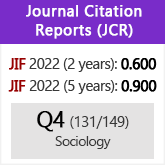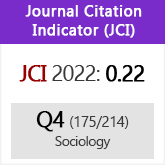Main household breadwinners aged between 25 and 34 years old in Spain (2006, 2011 and 2015)
DOI:
https://doi.org/10.3989/ris.2020.78.1.18.064Keywords:
Breadwinner, Economic crisis, Independence, Spain, YouthAbstract
It is proposed to know the influence of certain socioeconomic variables depending on whether a young person is the main breadwinner of his or her household, or the child of the main breadwinner. In this way, an approximation is made to the independence of youth. Taking three specific dates as a reference -2006, 2011 and 2015-, the aim is to ascertain the extent to which the economic recession is affecting them. Descriptive analyses and binary logistic regressions have been done, using the Household Budget Survey. There are some differences depending on the year, as well as some general trends. A higher level of education increases the probability that a youth is the child of the main breadwinner of the household, while being male, between 30 and 34 years old or receiving a salary greater than €1,000 is closer to the profile of breadwinner. As for the main breadwinners, a male aged 30 to 34 with an income level greater than €1,000 is the profile closest to a permanent contract.
Downloads
References
Ahn, N. y V. Sánchez-Marcos. 2017. "Emancipation under the great recession in Spain". Review of Economics of the Household 15(2): 477-495. https://doi.org/10.1007/s11150-015-9316-7
Arnett, J. J. 2014. Emerging adulthood: The winding road from the late teens through the twenties. New York: Oxford University Press. https://doi.org/10.1093/acprof:oso/9780199929382.001.0001
Aparicio-Fenoll, A. y V. Oppedisano, V. 2012. "Fostering the emancipation of young people: evidence from a Spanish rental subsidy". Working Papers 6651. Institute for the Study of Labor (IZA).
Ayuso, L. 2010. "Juventud y familia en los comienzos del siglo XXI". Pp. 115-175 en Jóvenes españoles 2010. Madrid: Fundación Santa María.
Becker, S. O., S. Bentolila, A. Fernandes y A. Ichino. 2010. "Youth emancipation and perceived job insecurity of parents and children". Journal of Population Economics 23(3): 1047-1071. https://doi.org/10.1007/s00148-008-0224-5
Berngruber, A. 2015. "Generation boomerang in Germany? Returning to the parental home in young adulthood". Journal of Youth Studies 18(10): 1274-1290. https://doi.org/10.1080/13676261.2015.1039969
Blossfeld, H. P., E. Klijzing, M. Mills y K. Kurz. 2006. Globalization, uncertainty and youth in society: The losers in a globalizing world. London: Routledge. https://doi.org/10.4324/9780203003206
Bourdieu, P. 2000. Contrafuegos: reflexiones para servir a la resistencia contra la invasión neoliberal. Barcelona: Anagrama.
Burn, K. y C. Szoeke. (2016). "Boomerang families and failure-to-launch: Commentary on adult children living at home". Maturitas 83: 9-12. https://doi.org/10.1016/j.maturitas.2015.09.004 PMid:26597141
Ermisch, J. 1999. "Prices, parents, and young people's household formation". Journal of Urban Economics 45(1): 47-71. https://doi.org/10.1006/juec.1998.2083
Ermisch, J. y P. Di Salvo. 1997. "The economic determinants of young people's household formation". Económica 64(256): 627-644. https://doi.org/10.1111/1468-0335.00103
Eurostat (2016). Youth unemployment by sex, age and educational attainment level. Consulta 10 de junio de 2017 (https://appsso.eurostat.ec.europa.eu/nui/show. do?dataset=yth_empl_090&lang=en).
Fernández, J. A. (1997). "Youth residential independence and autonomy: A comparative study". Journal of family issues 18(6): 576-607. https://doi.org/10.1177/019251397018006002
García, M. y R. Merino. 2006. "Transición a la vida adulta: nuevas y viejas desigualdades en función del género". Revista Española Internacional de Sociología 113: 155-162. https://doi.org/10.2307/40184729
García-Montalvo, J. (2009). "La inserción laboral de los universitarios y el fenómeno de la sobrecualificación en España". Papeles de economía española 119: 172-187.
Garrido, L., M. Requena y J. Rivière. 1995. La emancipación de los jóvenes en España. Madrid: Ministerio de Trabajo e inmigración, INJUVE.
Gee, E., B. Mitchell y A. Wister. 1995. "Returning to the parental "nest": exploring a changing canadian life course". Canadian Studies in Population 22(2): 121-144. https://doi.org/10.25336/P6WK5T
Gentile, A. 2010. "De vuelta al nido en tiempos de crisis. Los boomerang kids españoles". Revista de estudios de juventud 90: 181-203.
Gentile, A. 2015. "Jóvenes titulados superiores en la encrucijada de la crisis". Recerca, Revista de Pensament i Anàlisi 16: 35-58. https://doi.org/10.6035/Recerca.2015.16.3
Gentile, A. 2016. "La emancipación juvenil en tiempos de crisis: un diagnóstico para impulsar la inserción laboral y la transición residencial". Metamorfosis 119-124.
Giannelli, G. y C. Monfardini. 2003. "Joint decisions on household membership and human capital accumulation of youths. The role of expected earnings and local markets". Journal of Population Economics 16(2): 265-285. https://doi.org/10.1007/s001480200119
Hernández, J. 2012a. "¿Flexibilidad laboral, flexiseguridad o flexplotación?". Revista de Relaciones Laborales 26: 131-159.
Hernández, J. 2012b. "La inserción laboral de los jóvenes y las características del Empleo juvenil. Diferencias entre la región de Murcia y España". En: El mercado laboral de los jóvenes en la región de Murcia. Murcia, CES.
Hernández, M., y D. López Carmona. 2015. "Jóvenes españoles vulnerables en tiempos de crisis. Un enfoque multidimensional". Aposta. Revista de Ciencias Sociales 67: 9-32.
Hidalgo, A. y S. Pérez. 2004. Aspectos salariales de los jóvenes trabajadores. Madrid: Instituto de la Juventud.
Iacovou, M. 2010. "Leaving home: Independence, togetherness and income". Advances in Life Course Research 15(4): 147-160. https://doi.org/10.1016/j.alcr.2010.10.004
Instituto Nacional de Estadística. 2006. Encuesta de Presupuestos Familiares. Consulta 25 de septiembre de 2017 (https://bit.ly/2O4nVye).
Instituto Nacional de Estadística. 2011. Encuesta de Presupuestos Familiares. Consulta 25 de septiembre de 2017 (https://bit.ly/2O4nVye).
Instituto Nacional de Estadística. 2015. Encuesta de Presupuestos Familiares. Consulta 25 de septiembre de 2017 (https://bit.ly/2O4nVye).
Instituto Nacional de Estadística. 2017. Encuesta de Población Activa. Consulta 18 de agosto de 2017 (https://bit. ly/2RwoNOc).
Instituto Nacional de Estadística (2018). Encuesta de Presupuestos Familiares. Consulta 28 de septiembre de 2017 (https://bit.ly/2O4nVye).
Jones, G. (1995). Leaving home. Buckingham: Open University Press.
Jurado, T. (2006). "El creciente dinamismo familiar frente a la ineflexibilidad del modelo de vivienda español". Cuadernos de Información Económica 193: 117-126.
Jurado, T. 2007. "La precariedad temporal-salarial y sus efectos sobre la formación familiar". Sociedad y Utopía 29: 367-403.
Lary, B. 2015. Perceptions of empty nest mothers from diverse socioeconomic backgrounds with boomerang kids. PhD, College of Social and Behavioral Sciences. Walden University.
Lee, K. O. y G. Painter. 2013. "What happens to household formation in a recession?". Journal of Urban Economics 76: 93-109. https://doi.org/10.1016/j.jue.2013.03.004
López, A. 2005. "Excluidos pero trabajadores: el círculo vicioso de los 'trabajadores con bajo salario' en España". Cuadernos de Relaciones Laborales 23(1): 153-174.
López, A. 2006. "La familia como respuesta a las demandas de individualización: ambivalencias y contradicciones". Papers. Revista de Sociología 79: 263-284. https://doi.org/10.5565/rev/papers/v79n0.836
Manacorda, M. y E. Moretti. 2006. "Why do most Italian youths live with their parents? Intergenerational transfers and household structure". Journal of the European Economic Association 4(4): 800-829. https://doi.org/10.1162/JEEA.2006.4.4.800
Martínez-Granado, M. y J. Ruiz-Castillo. 2002. "The decisions of Spanish youth: A cross-section study". Journal of Population Economics 15(2): 305-330. https://doi.org/10.1007/s001480100082
Martins, N. y E. Villanueva. 2009. "Does high cost of mortgage debt explain why young adults live with their parents?". Journal of the European Economic Association 7(5): 974-1010. https://doi.org/10.1162/JEEA.2009.7.5.974
Melo, J. y P. Miret. 2010. "Transición a la vida adulta en España: una comparación en el tiempo y en el territorio utilizando el análisis de entropía". Revista Internacional de Sociología 131: 75-107.
Ministerio de Empleo. 2017. Evolución Salario Mínimo Interprofesional. Consulta 10 de octubre de 2017 (http:// www.empleo.gob.es/estadisticas/bel/SMI/index.htm).
Miret, P. 2006. "Escolarización, mercado de trabajo y emancipación familiar en España: un análisis longitudinal a escala de Comunidad Autónoma". Papeles de Geografía 43: 73-92.
Miret, P. 2007. "Vivir aún en casa o tener casa propia: emancipación residencial en España, 1976-2007". ACE, Arquitectura, Ciudad y Entorno 2(5): 301-330.
Mitchell, B. 2004. "Home, but not alone: Socio-cultural and economic aspects of canadian young adults sharing parental households". Atlantis: Critical Studies in Gender, Culture & Social Justice 28(2): 115-125.
Moreno, A. 2012a. "The transition to adulthood in Spain in a comparative perspective the incidence of structural factors". Young 20(1): 19-48. https://doi.org/10.1177/110330881102000102
Moreno, A. 2012b. "Transiciones familiares y residenciales". Pp. 52-73 en La transición de los jóvenes a la vida adulta. Crisis económica y emancipación tardía. Barcelona: Fundación La Caixa.
Mykyta, L. 2012. "Economic downturns and the failure to launch: The living arrangements of young adults in the US 1995-2011". Working Paper, 24. US Census Bureau Social, Economic and Housing Statistics Division (SEHSD).
Observatorio de Emancipación. 2009. OBJOVI 26, Primer trimestre de 2009. Consejo de la Juventud de España. Consulta 5 de junio de 2017 (http://www.cje.org/es/publicaciones/publicaciones-periodicas/objovi-26/).
Ortega, A. y P. Martín. 2012. "La juventud española en tiempos de crisis: Paro, vidas precarias y acción colectiva". Sociología del trabajo 75: 93-110.
Pérez-Baleón, G. F. 2012. "Desigualdades de género en el inicio de la vida laboral estable". Papeles de población 18(72): 213-246.
Requena, M. 2002. "Juventud y dependencia familiar en España". Revista De Estudios De Juventud 58(02): 12-24.
Shanahan, M. J. (2000). "Pathways to adulthood in changing societies: Variability and mechanisms in life course perspective". Annual Review of Sociology 26: 667-692. https://doi.org/10.1146/annurev.soc.26.1.667
Snyder, K. A. 2014. "Globalization and the changing course of adulthood". Contemporary Sociology: A Journal of Reviews 43(2): 183-186. https://doi.org/10.1177/0094306114522414c
South, S. J. y L. Lei. 2015. "Failures-to-launch and boomerang kids: Contemporary determinants of leaving and returning to the parental home". Social Forces 94(2): 863-890. https://doi.org/10.1093/sf/sov064 PMid:28989195 PMCid:PMC5627656
Vieira, J. M. y Gamundi, P. M. (2010). "Transición a la vida adulta en España: una comparación en el tiempo y en el territorio utilizando el análisis de entropía". Revista Española de Investigaciones Sociológicas (REIS), 131(33): 75-107.
Vosko, L. F. 2010. Managing the margins: Gender, citizenship and the international regulation of precarious employment. New York, NY: Oxford University Press.
White, L. 1994. "Coresidence and leaving home: Young adults and their parents". Annual Review of Sociology 20: 81-102. https://doi.org/10.1146/annurev.so.20.080194.000501
Williams, R. 2012. "Using the margins command to estimate and interpret adjusted predictions and marginal effects". Stata Journal 12(2): 308-331 https://doi.org/10.1177/1536867X1201200209
Published
How to Cite
Issue
Section
License
Copyright (c) 2020 Consejo Superior de Investigaciones Científicas (CSIC)

This work is licensed under a Creative Commons Attribution 4.0 International License.
© CSIC. Manuscripts published in both the printed and online versions of this Journal are the property of Consejo Superior de Investigaciones Científicas, and quoting this source is a requirement for any partial or full reproduction.All contents of this electronic edition, except where otherwise noted, are distributed under a “Creative Commons Attribution 4.0 International” (CC BY 4.0) License. You may read here the basic information and the legal text of the license. The indication of the CC BY 4.0 License must be expressly stated in this way when necessary.
Self-archiving in repositories, personal webpages or similar, of any version other than the published by the Editor, is not allowed.

















